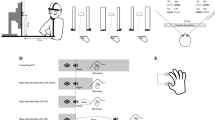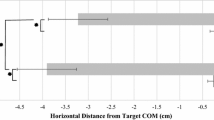Abstract
Vision plays a crucial role in guiding motor actions. But sometimes we cannot use vision and must rely on our memory to guide action—e.g. remembering where we placed our eyeglasses on the bedside table when reaching for them with the lights off. Recent studies show subjects look towards the index finger grasp position during visually-guided precision grasping. But, where do people look during memory-guided grasping? Here, we explored the gaze behaviour of subjects as they grasped a centrally placed symmetrical block under open- and closed-loop conditions. In Experiment 1, subjects performed grasps in either a visually-guided task or memory-guided task. The results show that during visually-guided grasping, gaze was first directed towards the index finger’s grasp point on the block, suggesting gaze targets future grasp points during the planning of the grasp. Gaze during memory-guided grasping was aimed closer to the blocks’ centre of mass from block presentation to the completion of the grasp. In Experiment 2, subjects performed an ‘immediate grasping’ task in which vision of the block was removed immediately at the onset of the reach. Similar to the visually-guided results from Experiment 1, gaze was primarily directed towards the index finger location. These results support the 2-stream theory of vision in that motor planning with visual feedback at the onset of the movement is driven primarily by real-time visuomotor computations of the dorsal stream, whereas grasping remembered objects without visual feedback is driven primarily by the perceptual memory representations mediated by the ventral stream.






Similar content being viewed by others
References
Ballard DH, Hayhoe MM, Pelz JP (1995) Memory representations in natural tasks. J Cogn Neurosci 7:66–80
Berthler NE, Clifton RK, Gullapalli V, McCall DD, Robin DJ (1996) Visual information and object size in the control of reaching. J Mot Behav 28:187–197
Binsted G, Chua R, Helsen W, Elliott D (2001) Eye–hand coordination in goal-directed aiming. Hum Mov Sci 20:563–585
Brouwer AM, Franz VH, Gegenfurtner KR (2009) Differences in fixations between grasping and viewing objects. J Vision 9:1–24
Brown LE, Halpert BA, Goodale MA (2005) Peripheral vision for perception and action. Exp Brain Res 165:97–106
Chieffi S, Gentilucci M (1993) Coordination between the transport and the grasp components during prehension movements. Exp Brain Res 94:471–477
Connolly JD, Andersen RA, Goodale MA (2003) FMRI evidence for a “parietal reach region” in the human brain. Exp Brain Res 153:140–145
Culham JC, Valyear K (2006) Human parietal cortex in action. Curr Opin Neurobiol 16:205–212
De Grave DDJ, Hesse C, Brouwer AM, Franz VH (2008) Fixation locations when grasping partly occluded objects. J Vision 8:1–11
Desanghere L, Marotta JJ (2008) The specificity of learned associations in visuomotor and perceptual processing. Exp Brain Res 187:595–601
Desanghere L, Marotta JJ (2011) “Graspability” of objects affects gaze patterns during perception and action tasks. Exp Brain Res 212:177–187
Efron R (1968) What is perception? Humanities Press, New York
Elliot D, Calvert R (1990) The influence of uncertainty and premovement visual information on manual aiming. Can J Psychol 44:501–511
Elliott D, Madalena J (1987) The influence of premovement visual information on manual aiming. Q J Exper Psychol A 39:541–559
Flanagan JR, Johansson RS (2003) Action plans used in action observation. Nature 424:769–771
Flanagan JR, Terao Y, Johansson RS (2008) Gaze behavior when reaching to remembered targets. J Neurophysiol 100:1533–1543
Glover S (2003) Optic ataxia as a deficit specific to the on-line control of actions. Neurosci Biobehav Rev 27:447–456
Goodale MA, Milner AD (1992) Separate visual pathways for perception and action. Trends Neurosci 15:20–25
Goodale MA, Kroliczak G, Westwood DA (2005) Dual routes to action: contributions of the dorsal and ventral streams to adaptive behavior. Prog Brain Res 149:269–283
Grea H, Pisella L, Rossetti Y, Desmurget M, Tilikete C, Grafton S, Prablanc C, Vighetto A (2002) A lesion of the posterior parietal cortex disrupts on-line adjustments during aiming movements. Neuropsychologia 40:2471–2480
Heath M, Binsted G (2007) Visuomotor memory for target location in near and far reaching spaces. J Mot Behav 39:169–177
Heath M, Rival C, Neely K (2006) Visual feedback schedules influence visuomotor resistance to the Muller-Lyer figures. Exp Brain Res 168:348–356
Hesse C, Franz VH (2009) Memory mechanisms in grasping. Neuropsychologia 47:1532–1545
Hesse C, Franz VH (2010) Grasping remembered objects: exponential decay of the visual memory. Vision Res 50:2642–2650
Himmelbach M, Karnath HO (2005) Dorsal and ventral stream interaction: contributions from optic ataxia. J Cogn Neurosci 17:632–640
Hu Y, Goodale MA (2000) Grasping after a delay shifts size-scaling from absolute to relative metrics. J Cogn Neurosci 12:856–868
Hu Y, Eagleson R, Goodale MA (1999) The effects of delay on the kinematics of grasping. Exp Brain Res 126:109–116
Jakobson LS, Goodale MA (1991) Factors affecting higher- order movement planning: a kinematic analysis of human prehension. Exp Brain Res 86:199–208
Jeannerod M (1984) The timing of natural prehension movements. J Mot Behav 16:235–264
Johansson RS, Westling G, Backstrom A, Flanagan JR (2001) Eye–hand coordination in object manipulation. J Neurosci 21:6917–6932
Kowler E, Blaser E (1995) The accuracy and precision of saccades to small and large targets. Vision Res 35:1741–1754
Land M, Mennie N, Rusted J (1999) The roles of vision and eye movements in the control of activities of daily living. Perception 28:1311–1328
Melcher D, Kowler E (1999) Shapes, surfaces, and saccades. Vision Res 39:2929–2946
Melmoth DR, Grant S (2006) Advantages of binocular vision for the control of reaching and grasping. Exp Brain Res 171:371–388
Milner AD, Goodale MA (2006) The visual brain in action. Oxford University Press, UK
Milner AD, Dijkerman HC, Pisella L, McIntosh R, Tilikete C, Vighetto A, Rossetti Y (2001) Grasping the past: delay can improve visuomotor performance. Curr Biol 11:1896–1901
Milner AD, Dijkerman HC, McIntosh RD, Rossetti Y, Pisella L (2003) Delayed reaching and grasping in patients with optic ataxia. Prog Brain Res 142:225–242
Neggers SF, Bekkering H (2000) Ocular gaze is anchored to the target of an ongoing pointing movement. J Neurophysiol 83:639–651
Radoeva PD, Cohen JD, Corballis PM, Lukovits TG, Koleva SG (2005) Hemispheric asymmetry in a dissociation between the visuomotor and visuoperceptual streams. Neuropsychologia 43:1763–1773
Rolheiser TM, Binsted G, Brownell KJ (2006) Visuomotor representation decay: influence on motor systems. Exp Brain Res 173:698–707
Salvucci DD, Goldberg JH (2000) Identifying fixations and saccades in eye-tracking protocols. In: Duchowski AT (ed) Proceedings of the eye tracking research and applications symposium. ACM Press, New York, pp 71–78
Santello M, Flanders M, Soechting JF (2002) Patterns of hand motion during grasping and the influence of sensory guidance. J Neurosci 22:1426–1435
Saunders JA, Knill DC (2004) Visual feedback control of hand movements. J Neurosci 24:3223–3234
Schettino LF, Adamovich SV, Poizner H (2003) Effects of object shape and visual feedback on hand configuration during grasping. Exp Brain Res 151:158–166
Thomson JA (1983) Is continuous visual monitoring necessary in visually guided locomotion? J Exp Psychol Hum Percept Perform 9:427–443
Westwood DA, Goodale MA (2003) Perceptual illusion and the real-time control of action. Spat Vis 16:243–254
Westwood DA, Roy EA, Heath M (2003) No evidence for accurate visuomotor memory: systematic and variable error in memory-guided reaching. J Mot Behav 35:127–133
Whitwell RL, Goodale MA (2009) Updating the programming of a precision grip is a function of recent history of available feedback. Exp Brain Res 194:619–629
Whitwell RL, Lambert LM, Goodale MA (2008) Grasping future events: explicit knowledge of the availability of visual feedback fails to reliably influence prehension. Exp Brain Res 188:603–611
Wing AM, Turton A, Fraser C (1986) Grasp size and accuracy of approach in reaching. J Mot Behav 18:245–260
Winges SA, Weber DJ, Santello M (2003) The role of vision on hand preshaping during reach to grasp. Exp Brain Res 152:489–498
Acknowledgments
We thank Kamyar Abhari for his technical assistance. This work was supported by a Postdoctoral Fellowship from the Canadian Institutes of Health Research (CIHR) held by S. L. Prime and a grant from the Natural Sciences and Engineering Research Council of Canada (NSERC) held by J. J. Marotta.
Author information
Authors and Affiliations
Corresponding author
Rights and permissions
About this article
Cite this article
Prime, S.L., Marotta, J.J. Gaze strategies during visually-guided versus memory-guided grasping. Exp Brain Res 225, 291–305 (2013). https://doi.org/10.1007/s00221-012-3358-3
Received:
Accepted:
Published:
Issue Date:
DOI: https://doi.org/10.1007/s00221-012-3358-3




